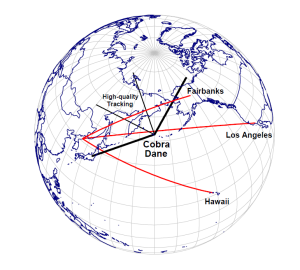According to the Air Force, if sequestration goes into effect, it would have to make cuts in radar operations that would have the effect of “significantly impacting national missile defense, space situational awareness, and the intelligence community.”[1] Specifically, radar operations at Cavalier Air Force Station in North Dakota and at Earecksen Air Station, Alaska and operation the Air Force Space Surveillance System (AFSSS) would be reduced from 24 to 8 hours per day.
Would such reductions actually seriously impact U.S. missile defenses?
Coverage of the Cobra Dane radar at Earecksen Air Station, Shemya Island, Alaska. Figure from Union of Concerned Scientists, Technical Realities, p. 37.[2]
The large phased-array PARCS (Perimeter Acquisition Radar Attack Characterization System) radar at Cavalier, which was originally built part of the Safeguard Anti-ballistic Missile System, is now used for missile attack warning and space surveillance. Earecksen Air Station on Shemya Island at the western end of the Aleutians is the home of the Cobra Dane, a large-phased array L-band radar originally built to gather intelligence on Soviet missile tests, but which is now also used for missile warning, missile defense and space surveillance. The AFSSS is a radar “fence” stretching across the southern United States that detects satellites as they pass over it, and is a dedicated component of the U.S. Space Surveillance Network (SSN).
In terms of missile defense, the impact of these temporary (presumably) cutbacks in radar operations seems pretty minimal. PARCS is not part of the current GMD national missile defense system, and the AFSSS does not have (and cannot be given) any ballistic missile defense capabilities. While Cobra Dane has been part of the GMD system since the GMD was first declared operational, because of its poor orientation it has never participated in an intercept test. While Cobra Dane can potentially provide much higher resolution radar data than the Pave Paws radar in California, it can only do so within a narrow region within 22 degrees of its boresite, which a missile from North Korea towards the U.S. west coast would spend little if any of its trajectory within (as shown in figure above). Nor does removing these radars from the early warning network open up any gaps in the coverage provided by the five BMEWS and Pave Paws early warning radars.
The impact on space surveillance seems potentially much more significant. Cobra Dane can detect and track smaller objects in low earth orbit than any of the SSN’s other sensors (down to as small as about 5 cm, although it only tracks a small fraction of such objects). It has this small-object capability largely because it operates at a higher frequency (about 1.3 GHz) than other seven large phased-array radars in the SSN, all of which operate in the UHF band at about 440 MHz. PARCS, although not ideally situated for space surveillance (it is in North Dakota, facing north) is, along with the FPS-85 radar in Florida, one of the two most powerful of the large UHF phased-array radars in the SSN. The AFSSS, while it cannot detect objects much smaller than about 30 cm in diameter, nevertheless produces thousands of measurements every day on space objects that pass through its radar fence.
[1] Maggie Ybarra, “Air Force Lists Programs that Sequestration Cuts Would Hit Hardest,” Inside Defense SITREP, February 19, 1993.
[2] Lisbeth Gronlund, David C. Wright, George N. Lewis, and Philip E. Coyle, Technical Realities: an Analysis of the 2004 Deployment of a U.S. National Missile Defense System (Cambridge, Mass. Union of Concerned Scientists, 2004). Available at: http://www.ucsusa.org/assets/documents/nwgs/technicalrealities_fullreport.pdf.

